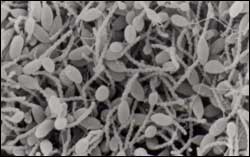Bacteria feed on smelly breath (and feet)

Hyphomicrobium sulfonivorans
Researchers have isolated bacteria which can grow on and ‘mop up’ smelly compounds in the mouth that are linked to bad breath. These smelly, highly reactive ‘one-carbon’ compounds are naturally produced from the breakdown of sulphur-containing amino acids in the mouth.
Dr Ann Wood and her colleagues at Kings College, London, reported these findings in the August issue of Environmental Microbiology. The odour-eating methylotrophic bacteria were isolated from the tongue, tooth plaques (supra-gingival plaques) and gum edge (sub-gingival plaques) of volunteers. They include strains of Bacillus, Brevibacterium casei, Hyphomicrobium sulfonivorans1, Methylobacterium, Micrococcus luteus and Variovorax paradoxus.
The composition and function of bacterial flora of the mouth have been extensively studied in the past, but until now it was not recognised that methylotrophic bacteria are part of the normal oral microbial environment or ‘microflora’.
The researchers found no difference between strains of bacteria found in the mouths of healthy volunteers and those suffering from progressive gum disease (periodontitis), a condition which is often associated with smelly breath. However, no assessment was made of the levels of methylotrophic bacteria present, low levels of which may be associated with bad breath.
In a previous paper, Dr Wood et al found that the foot is also a source of methylated sulphides and strains of these odour eating bacteria, including Brevibacterium and Methylobacterium, which are also part of the normal foot microbial flora.
The results of this study will assist future investigation into the detection of the levels of methylotrophic bacteria and their possible relationship with the oral concentrations of methylated sulphides. This may lead to a natural way of reducing smelly breath and feet.
Media Contact
More Information:
http://www.blackwell-synergy.com/toc/emi/7/8All latest news from the category: Life Sciences and Chemistry
Articles and reports from the Life Sciences and chemistry area deal with applied and basic research into modern biology, chemistry and human medicine.
Valuable information can be found on a range of life sciences fields including bacteriology, biochemistry, bionics, bioinformatics, biophysics, biotechnology, genetics, geobotany, human biology, marine biology, microbiology, molecular biology, cellular biology, zoology, bioinorganic chemistry, microchemistry and environmental chemistry.
Newest articles

Zap Energy achieves 37-million-degree temperatures in a compact device
New publication reports record electron temperatures for a small-scale, sheared-flow-stabilized Z-pinch fusion device. In the nine decades since humans first produced fusion reactions, only a few fusion technologies have demonstrated…

Innovative microscopy demystifies metabolism of Alzheimer’s
Researchers at UC San Diego have deployed state-of-the art imaging techniques to discover the metabolism driving Alzheimer’s disease; results suggest new treatment strategies. Alzheimer’s disease causes significant problems with memory,…

A cause of immunodeficiency identified
After stroke and heart attack: Every year, between 250,000 and 300,000 people in Germany suffer from a stroke or heart attack. These patients suffer immune disturbances and are very frequently…





















